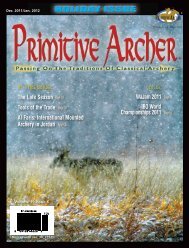In This Issue: plus: - Primitive Archer Online
In This Issue: plus: - Primitive Archer Online
In This Issue: plus: - Primitive Archer Online
Create successful ePaper yourself
Turn your PDF publications into a flip-book with our unique Google optimized e-Paper software.
Drawings of excavated Guarani Stone points.<br />
Guaraní which means foreigner) were<br />
made slaves to the Guaraní, while others<br />
were consumed by the Guaraní in a form<br />
of ritual cannibalism. The Guaraní<br />
believed that by consuming their defeated<br />
enemies, they gained power from their<br />
dead enemies.<br />
One of the rights of passage for<br />
Guaraní boys to become a man and before<br />
he could marry was to kill an enemy in a<br />
ritual ceremony. Another interesting facet<br />
of the Guaraní culture was once a Guaraní<br />
man became a father, immediately after the<br />
birth of his child he had to fast for 15 days,<br />
during which time he was restricted from<br />
making any type of weapon.<br />
Guaraní Botany and Hunting<br />
Due to the semi-nomadic character of<br />
these people, the early Guaraní left no<br />
evidence of their culture. However, they<br />
developed such an extensive base of<br />
knowledge of the flora and fauna that<br />
when the first Europeans arrived, they<br />
recognized the scope of this knowledge<br />
and relied on it extensively. An example of<br />
this is that the Guaraní language is the<br />
most widely used to name flora and fauna,<br />
third only to Latin and Greek. Even today<br />
Guaraní are sought out for their<br />
knowledge of local plant and animal life.<br />
My good friend Roberto Rodas who is the<br />
grandson of a Guaraní chief, demonstrated<br />
Two photographs showing how the feathers and arrow point are<br />
wrapped with philodendron vine<br />
Guarani arrow points<br />
Actual stone tools that were<br />
excavated. These are Guarani<br />
and were found in Brazil.<br />
to my wife, Cecilia, and I the plants used<br />
to stop itching and to repel insects.<br />
Guarani Bows and Arrows<br />
The bows used by the Guaraní were<br />
long, measuring two meters (about 78") in<br />
length. The war arrows of the Guaraní<br />
were tipped with points made from human<br />
bones. Each Guaraní bow was<br />
distinguishable from other Guaraní bows<br />
because the maker marked his bow to be<br />
readily identifiable to the entire<br />
community. For example, no two Guaraní<br />
bows were designed the same and neither<br />
were the arrows that went with a particular<br />
bow. Unlike Native American bows and<br />
arrows, for example, the Hupa bows which<br />
are paddle shaped or the Lakota bows<br />
which are readily identifiable because of<br />
their design, such was and is not the case<br />
with the Guaraní bows and arrows. The<br />
favorite colors to decorate bows were black<br />
and white, black and brown, or all red.<br />
A close-up picture showing<br />
how the philodendron vine is<br />
twisted into a bow string. The<br />
name for the vine in Guarani is<br />
Guembe-Pi.<br />
www.<strong>Primitive</strong><strong>Archer</strong>.com Volume 21 <strong>Issue</strong> 1 25



